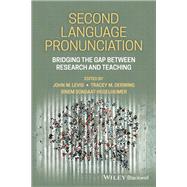Practical resources designed to help language educators apply the latest research and most effective pedagogical methods to classroom pronunciation instruction
In Second Language Pronunciation: Bridging the Gap Between Research and Teaching, a team of distinguished researchers and educators delivers an incisive and practical approach to evidence-based pronunciation instruction in second language classrooms. Developed for language teachers who want to incorporate and implement the most effective pedagogical methods in their language instruction, this edited volume offers 15 essays that connect the latest research with practical applications in the classroom.
In addition to exploring recent but less well-known methods—like High Variability Phonetic Training, discourse-based teaching, communicative classrooms, and technology-based methods—these chapters are unified in bringing theory to bear on practical questions faced by language teachers. The chapters follow a standard format, moving from critical research issues to pedagogical implications, and practical resources to equip language teachers, scholars, administrators, and teachers-in-training with the tools they require to develop their students’ pronunciation abilities. Readers will also find:
- A thorough introduction to using empirical evidence to guide pronunciation instruction in second language students
- Comprehensive explorations of the integration of pronunciation instruction into second language education
- Practical discussions of perception training in pronunciation instruction and the importance of L2 segmental and suprasegmental contrasts in pronunciation learning
- In-depth examinations of classroom research for pronunciation and the use of technology to explore L2 pronunciation
Perfect for upper-level undergraduate and graduate students studying TESOL, applied linguistics, and second language acquisition, Second Language Pronunciation: Bridging the Gap Between Research and Teaching will also earn a place in the libraries of researchers, scholars, and teachers of language and education.









